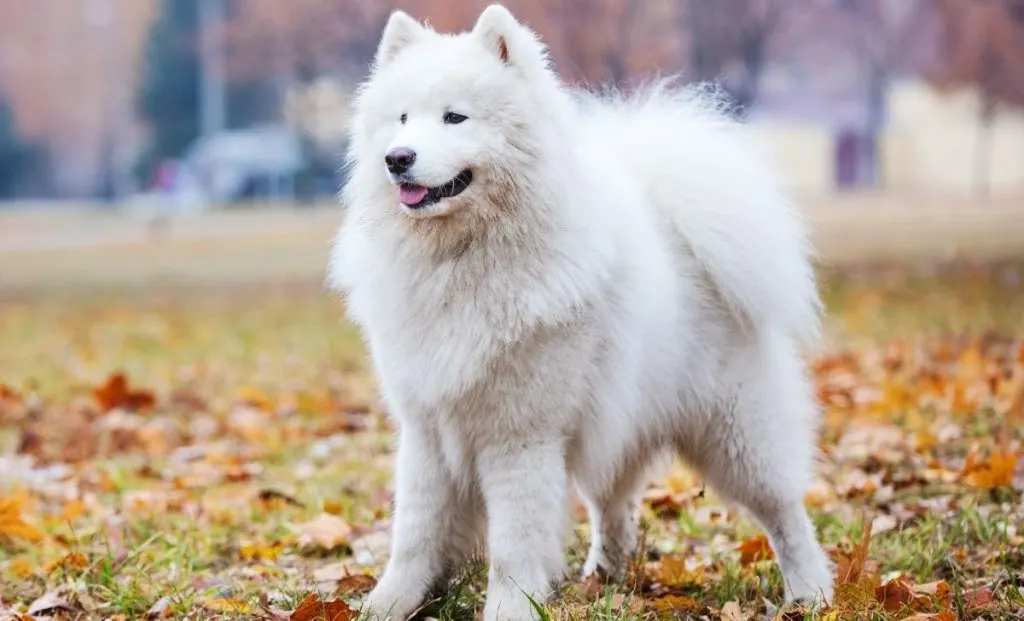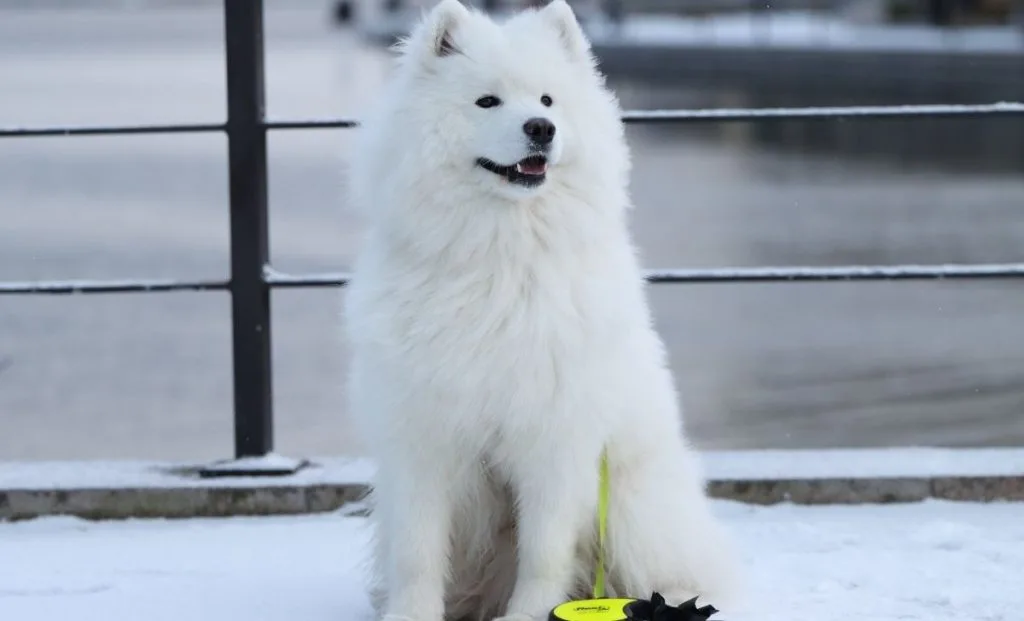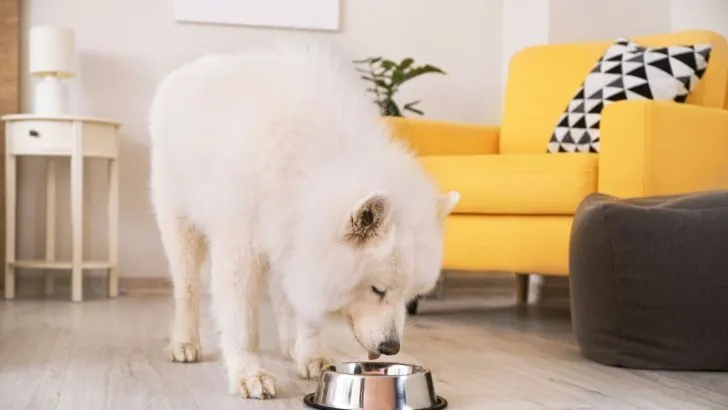Samoyeds are known for their friendly disposition and fluffy white coats. But they are also known for their healthy appetites!
Say hello to the ultimate Samoyed feeding chart where we aim to let you in on some top foods, raw food diet information, appropriate portion sizes, and lots of other yummy talk!
What I want you to keep in mind throughout this article is that Samoyeds are lively dogs that need a customized diet to sustain their high-energy lifestyle.
Therefore, proper nutrition is crucial to maintain their energy levels, coat health, and overall health.
Samoyed Feeding Chart By Age

Let’s start by showing you a quick and easy feeding chart to help you understand the amount of food your Samoyed needs at different stages of life.
This Samoyed feeding chart provides general feeding guidelines to ensure your pup gets the proper diet to stay healthy and energetic.
| Age | Feeding Frequency | Portion Sizes | Food Type |
| Puppies | 3-4 times a day | 1/2 to 1 cup per meal, adjust based on weight | High-quality puppy food, protein sources |
| Adolescents | 2-3 times a day | 1 to 2 cups per meal, adjust as needed | Mix of puppy and adult food, balanced diet |
| Adults | 2 times a day | 1.5 to 3 cups per meal, based on activity | High-quality adult dog food, lean meats |
| Seniors | 2 times a day | 1 to 2 cups per meal, smaller portions | Senior dog food, easily digestible, essential vitamins |
But remember, this is just an estimation. Each pup is an individual with specific dietary needs.
It’s crucial to adjust the feeding amounts based on your dog’s health, activity level, and age.
With that said, you can always follow the Samoyed growth chart to see how their development aligns with standard milestones, ensuring they receive the appropriate nutrition at each stage.
And remember to always consult your veterinarian to tailor your Sammy’s diet to their specific requirements.
Alright, let’s move further into the Samoyed feeding chart.
Samoyed Puppy Feeding Chart

Did you know that puppies require a diet higher in protein and fat compared to adult dogs in order to keep up with their rapid growth and development?
As with all babies, feeding a Samoyed puppy requires careful attention. Therefore, pet parents must make sure that their little cloud of fluff receives the best food possible, in order to support their digestive system and ultimately, their growth and development.
Not only do the puppies have different dietary needs than adult Samoyeds, but their feeding schedule changes as they grow.
Let’s see what happens!
Birth To 8 Weeks Of Age

This period is crucial for the puppy’s immune system development.
During the first eight weeks, Samoyed puppies go through quite a change. From little deaf and blind babies, to adventurous furballs full of joy and mischief.
So, at birth, they primarily rely on their mother’s milk, which has the best nutrient value to help build a healthy immune system and give them the best start in life.
If the mother is unable to feed, a puppy milk replacer should be used. Very young puppies (up to 8 weeks old) should be fed four times a day (1).
8 To 12 Weeks

At this stage, Samoyed puppies slowly transition from their mother’s milk to solid foods.
The transition can be made easy with puppy mush. This is made using a high-protein, large breed puppy kibble and mixing it with water or milk replacer. The liquid should thoroughly soften the kibble but not make it too soupy.
Transitioning to wet food can also be a good option for young puppies as it is easier to chew and digest. Like puppy mush, it also helps maintain their water intake, which is crucial at this age.
Now that we’ve mentioned chewing, you may experience the little one nibbling on you. Of course, this is due to their teething period, and you can help tackle this with chew toys. Don’t worry, they are not trying to eat you!
Pet parents must make sure that the wet food contains natural components and lean meats. Avoid cheaper food options that lack nutrient value at all costs.
Sammy pups are to be fed smaller amounts of food multiple times a day — typically four times daily. This helps manage their food intake and prevents digestive upset.
Each meal should be well-balanced, providing a mix of proteins, healthy fats, and essential vitamins. Avoid feeding actual human food or dairy products, as these can cause digestive issues.
3 To 6 Months

Feeding Samoyed puppies between 3 to 6 months old involves transitioning them to a more tailored diet that supports their rapid growth while making sure that they receive the right balance of nutrients.
This period is crucial for developing strong bones, muscles, and overall health.
Now that the pups are growing very fast, you may find yourself asking ”How much food should a Samoyed puppy eat?”
They typically require around 1,000 to 1,200 calories per day, depending on their activity level, growth rate, and individual metabolism. At this age, Sammy puppies should be fed three times a day.
If you think that this may not be enough, do not worry! This schedule helps manage their energy levels and prevents digestive upset.
This well-balanced diet will help prevent potential health issues like hip dysplasia and support their developing immune system.
6 To 12 Months

As Samoyed puppies grow from 6 to 12 months old, their nutritional needs change as they transition closer to adulthood.
Now, your little Samoyed requires about 2 to 3 cups of high-quality puppy food per day, divided into two to three meal times.
During this period, these large teddy-bear-like dogs need the best dog food on the market, that is exclusively formulated for large dog breeds.
Each meal should be carefully portioned to prevent overfeeding. Typically, Samoyed puppies will need about 2 to 3 cups of high-quality puppy food per day, divided into meals.
Focus on high-protein kibble to support muscle development, with lean meats such as chicken, beef, or fish as primary protein sources.
Samoyed Adult Feeding Chart
Welcome to adulthood! Now we can talk about adult Samoyeds that may still act like little puppies. Yes, large breeds like this take more time to mature than smaller dogs (2).
Regardless, they do not need puppy food anymore. Instead, they require a balanced diet with top-notch ingredients – a diet high in protein but moderate in fat.
As for their feeding schedule, opt for two meal times – once in the morning and once in the evening.
This proper diet helps them maintain muscle mass and energy levels while avoiding obesity (which Samoyeds are prone to).
Samoyed Senior Feeding Chart

As Samoyeds age, their dietary needs change to accommodate their reduced activity levels and potential age-related health issues.
With that said, senior Samoyeds dogs require a diet that supports joint health, maintains a healthy weight, and addresses any specific medical conditions.
Continue feeding senior Samoyeds twice a day, adjusting portions to prevent overeating. They now benefit from a diet lower in calories. Protein is still essential but focus on easily digestible sources.
It is also a good time to talk about supplements, even though these can be given to your dog earlier, depending on your vet’s advice.
Look for senior-specific dog food that includes added glucosamine and chondroitin for joint health.
Additionally, senior Samoyeds may have dental issues, so consider moistening dry food or offering wet food options.
What Is The Best Diet For A Samoyed?
The best types of dog foods to choose from are those with natural ingredients (without fillers) and human-grade ingredients.
Protein
They are active and muscular dogs that require a high-protein diet with real meat ingredients listed at the top of the list. Therefore, look for animal-based protein sources such as chicken, beef, lamb, and fish.
Protein should make up a significant portion of their diet, typically around 20-30%.
Healthy Fats
Samoyeds have a thick, harsh coat with a dense, soft undercoat (3).
This double coat protects them against arctic cold, indicating a need for nutrients that support skin and coat health, such as omega-3 and omega-6 fatty acids.
These healthy fats should constitute about 10-15% of their diet.
They are also very important for brain development and maintaining the energy levels of these furballs.
Carbohydrates
Samoyeds need some carbohydrates for their high energy levels.
Nutritious and healthy options include brown rice, oats, sweet potatoes, and peas. Fruits such as apples (without seeds), blueberries, and pumpkins can also be beneficial.
Vitamins And Minerals
A Samoyed’s diet should include a balanced mix of vitamins and minerals to support overall health, bone strength, and immune function.
Look for foods fortified with vitamins A, B, C, D, E, and minerals like calcium, phosphorus, and potassium.
Raw Diet For Samoyeds?

Feeding a raw diet to your Samoyed can be a healthy and natural option, mimicking what dogs might eat in the wild. However, careful planning is required to ensure it meets all their nutritional needs.
In fact, one study done on Bernese Mountain Dog puppies indicates that inadequate nutrient supply in “BARF” feeding plans can lead to severe developmental disorders, especially in large-breed puppies (4).
Therefore, if you want to put Sammy on a raw diet, I recommend consulting with your vet for a tailored approach.
It Is All About The Balance
As we move to the end of our Samoyed feeding chart, I want you to remember some key takeaways.
Apart from choosing the best food on the market, the most important thing is to measure portions carefully and adjust the amount of food based on its growth rate and activity level.
Overfeeding can lead to weight management issues while underfeeding can hinder their development (5).
Make sure to avoid feeding your Samoyed actual human food, especially those that are toxic to dogs, such as chocolate, grapes, onions, and garlic.
I have no doubt that you will come up with the best Samoyed feeding chart of your own, that best suits your furever friend. Happy feeding!
References
1. LP, Case & Daristotle, L. & MG, Hayek & Raasch, M.F.. (2011). Canine and Feline Nutrition. 10.1016/C2009-0-39175-8.
2. Trangerud, C., Grøndalen, J., Indrebø, A., Tverdal, A., Ropstad, E., & Moe, L. (2007). A longitudinal study on growth and growth variables in dogs of four large breeds raised in domestic environments.. Journal of animal science, 85 1, 76-83 . https://doi.org/10.2527/JAS.2006-354.
4. Mack, J., & Kienzle, E. (2016). [Inadequate nutrient supply in “BARF” feeding plans for a litter of Bernese Mountain Dog-puppies. A case report].. Tierarztliche Praxis. Ausgabe K, Kleintiere/Heimtiere, 44 5, 341-347 . https://doi.org/10.15654/TPK-151091.
3. Samoyed. (2020) Definitions. https://doi.org/10.32388/r6lw1u.
5. Reid, I., Roberts, C., & Baird, G. (1980). The effects of underfeeding during pregnancy and lactation on structure and chemistry of bovine liver and muscle. The Journal of Agricultural Science, 94, 239 – 245. https://doi.org/10.1017/S0021859600028100.

Meet Iram, a devoted veterinarian, passionate dog lover, and current Ph.D. candidate at Utrecht University in the Netherlands. Seamlessly blending her roles as a vet and content writer, Iram channels her love for dogs into heartfelt narratives.
Since childhood, Iram nurtured a dream of becoming a vet, a passion that runs deep in her family. Having now fulfilled that dream, she’s eager to share her acquired knowledge. In her writing, Iram not only explores the emotional bond between humans and their canine friends but also integrates her veterinary expertise, offering readers a holistic understanding of their beloved pets.
